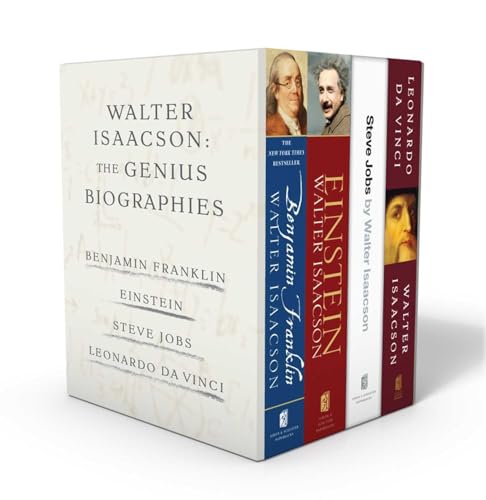If you’ve ever wished you could spend an awkward dinner with Einstein, Steve Jobs, Leonardo da Vinci, and Ben Franklin, well, Walter Isaacson’s work is probably the closest you’ll get. Welcome to my review of his blockbuster biography series, where genius meets bad hair days and poor fashion choices. If you’re curious about whether Isaacson’s hefty tomes are worth your precious eyeball time, I’ll share the honest ups, the occasional downs, and a few giggles I had while reading (and sometimes struggling to lift) these famous doorstops. Grab a comfy chair—let’s see if genius is as fun as it sounds!
Walter Isaacson: A Brief Book Summary
In a nutsheel
Ever wanted a peek inside the minds of some of history’s biggest brains? Well, Walter Isaacson’s biographies do exactly that. He’s the master of the biography genre—writing about real people, but making their lives feel more exciting than my attempt at cooking spaghetti.
In his books, Isaacson takes on legends like Steve Jobs, Leonardo da Vinci, Einstein, and even Ben Franklin. He shows how they mixed curiosity, stubbornness, and a dash of chaos to dream up new ideas. But it’s not all genius all the time—Isaacson also peeks at their quirks and facepalm moments.
The big themes? Creativity, teamwork (or sometimes the lack of it), and what it takes to change the world. You get a front row seat to moments of inspiration and also see how many cups of coffee it really takes to build an empire—or, in Einstein’s case, a new view of the universe.
Walter Isaacson’s Storytelling Style and Pacing: You Won’t Want to Blink
Let me tell you, reading a book by Walter Isaacson feels like sitting at a diner with the most interesting person in the world. Isaacson grabs you from the first page, and his writing flows so well you forget you’re supposed to be learning something. The man has a knack for weaving history, drama, and geeky details into a single smooth story. And don’t get me started on his chapter endings—he leaves you hanging just enough that you have to keep going, kind of like when you tell yourself you’ll only eat one more potato chip and then, oops, the bag is empty.
Now, about that pacing: Isaacson knows when to hit the gas and when to slow down. I never found myself wishing he would “get to the point already.” Still, there are moments (especially when he’s geeking out over technology or art) where a few sentences could have been trimmed. But hey, even the best storytellers get a little carried away, right? He juggles facts and personal anecdotes so well, the book never gets too dry or too fluffy. It’s a rare skill. Seriously, if Isaacson wrote instruction manuals, I’d finally learn how my blender really works.
But enough about style and pacing—I hope you’re ready, because next up, I’ll put on my detective hat and look at just how deep Isaacson goes with his biography research and detail. Spoiler: I found some surprises!
Walter Isaacson: A Master of Digging Deep – How He Researches Biographies
When it comes to research, Walter Isaacson is like that friend who arrives early to a costume party, asks about every snack, and then tells you all about the history of potato chips. His level of detail is pretty wild. I mean, after reading his biography of Leonardo da Vinci, I started seeing hidden meanings in my own refrigerator notes. Isaacson doesn’t just check Wikipedia, he goes to museums, talks to experts, and even tries to read backwards like Leonardo. Maybe he even tried to grow a Vitruvian beard.
In his biography of Steve Jobs, Isaacson did something I never do—he interviewed over 100 people! (I can barely get my friends to answer texts.) He doesn’t settle for the usual facts. He goes after weird childhood habits, notes from old teachers, and emails from the 1990s. If Jobs forgot what he ate for breakfast in 1968, odds are Isaacson found out. This makes the stories much richer, though sometimes I felt like there was almost too much detail. At one point, I was reading about Jobs’ fruit-only diet while eating bacon and felt a bit judged by history.
Ben Franklin, Albert Einstein, and Leonardo da Vinci all get the same treatment. Isaacson finds letters, doodles, and random lists that show who these folks really were. Sometimes, the detail got a bit thick, like quicksand for my brain. I found myself remembering strange facts, like Einstein hated socks, rather than the meaning of relativity. But hey, trivia night is much more fun now.
Next, I’ll be mixing up genius with a fun little showdown: how do these four heavyweights compare? Put on your thinking caps—this is gonna get spark-y!
Comparing Four Geniuses: Einstein, Jobs, Leonardo, and Franklin
Walter Isaacson might be the only person who could fit Einstein, Steve Jobs, Leonardo da Vinci, and Benjamin Franklin at the same dinner table. To be honest, I would love to be a fly on the wall at that dinner. Isaacson does not just tell their stories; he lets their odd quirks and bold moves shine bright, so you can spot what makes each genius tick.
Einstein shows up as the wild-haired thinker who loved to challenge the rules (and his teachers). His odd socks and habit of walking off with other people’s boats prove that being forgetful isn’t always bad. Leonardo, meanwhile, is a restless painter and inventor, always poking at new ideas but rarely finishing anything. You can almost hear Isaacson sigh every time Leonardo ditches one invention to invent something else.
Franklin brings the charm, turning awkward meetings into diplomatic breakthroughs. He’s the guy at the party who knows someone in every room. Jobs, though, is the driven artist with a temper. He wants to build beautiful things, even if it means stepping on some toes. With Isaacson’s touch, they all become real people and not just faces on money or names on your phone. He shows how their worlds shape them: Franklin with printing presses, Einstein with chalkboards, Leonardo with messy notebooks, and Jobs with sleek laptops.
If you want to know what life lessons you can learn from this bunch of oddballs, stick around—the next section will serve up wisdom fresh from four wild lives!
Real Life Lessons from Four Geniuses (with Thanks to Walter Isaacson)
Walter Isaacson does not just write thick books to fill your shelf with dust. No, the man packs them full with real, slap-you-in-the-face lessons. For example, from Einstein, I learned to question everything. When my wife caught me microwaving leftover pizza with the foil still on, I said, “Einstein would have asked, ‘What happens if I do this?’” (Note: it sparks.)
Then there’s Steve Jobs. You pick up that being a perfectionist can lead to greatness (or getting yelled at in meetings). Jobs showed the value of caring way too much about how things look and about pushing people harder than they like. But, also, maybe don’t throw tantrums if your phone is the wrong shade of gray.
Isaacson’s take on Leonardo da Vinci teaches that curiosity is a superpower. You’re never too old, bald, or Italian to pick up a notebook, draw weird stuff, and ask goofy questions. The man wrote backwards just to mess with people. Or maybe he was left-handed and didn’t want to smudge ink. Either way, stay curious!
And good ol’ Benjamin Franklin comes across as the ultimate life hacker. He hustled, pranked, and invented swimming fins because he wanted to swim faster. Franklin reminds us to laugh, tinker, and not take ourselves too seriously. (But do wear pants when you fly a kite in a storm.)
So, should you buy Walter Isaacson’s books? Absolutely! They’re funny, smart, and packed with wisdom. Just clear your calendar and your shelf—they’re hefty. 10/10 would recommend, as long as you keep the foil out of the microwave!
Conclusion
So, after going through Walter Isaacson’s books, I have to say I’m a fan. He makes these larger-than-life people feel like that kid in class who would both invent a time machine and forget where he left his lunch. From Einstein’s wild hair to Steve Jobs’ even wilder mood swings, Isaacson turns geniuses into people you could almost have coffee with (if you could get a word in).
His research is solid, and you get cool stories you won’t find in the movies. But sometimes, he gets a little too excited about every tiny fact. I caught myself wishing for less detail about Steve Jobs’ fruit diet and more about, well, literally anything else.
If you want to see what makes smart people tick—and laugh at their strange habits—these books are a good bet. Just be ready for some long tangents and the occasional rabbit hole about how many notebooks Leonardo da Vinci had.
This wraps up my Isaacson review. Go forth, read, and let your inner genius (or at least your inner bookworm) shine!


